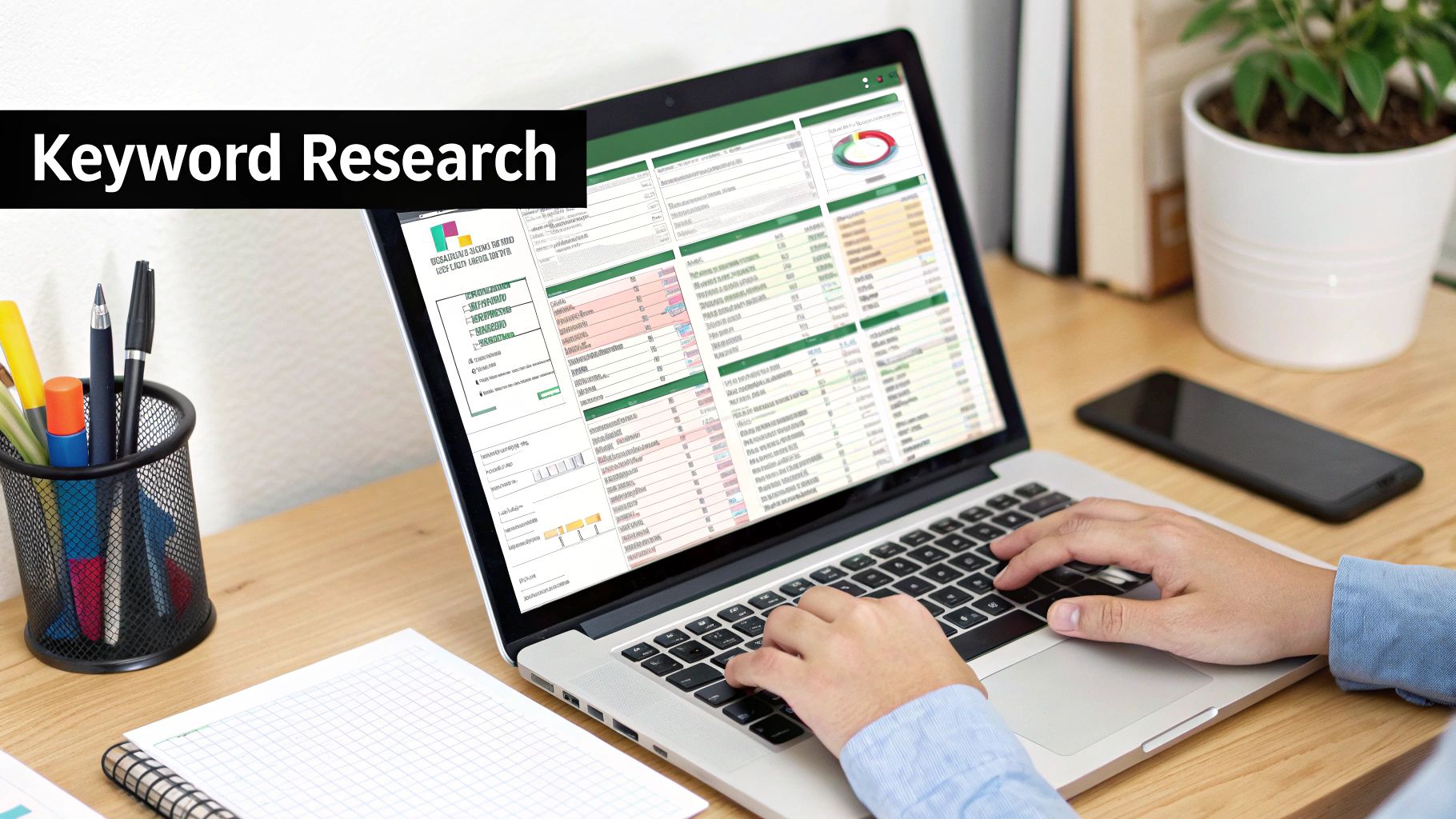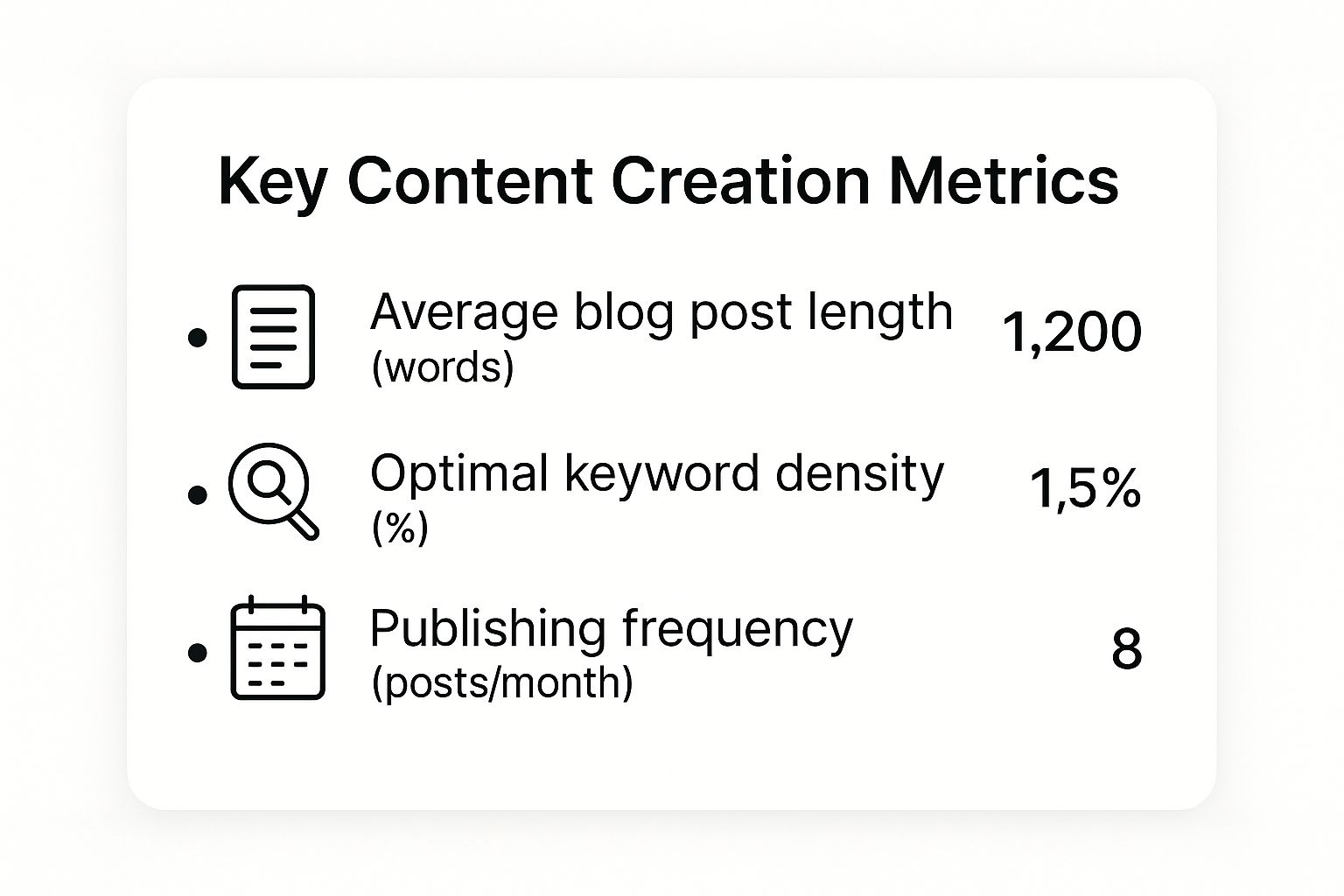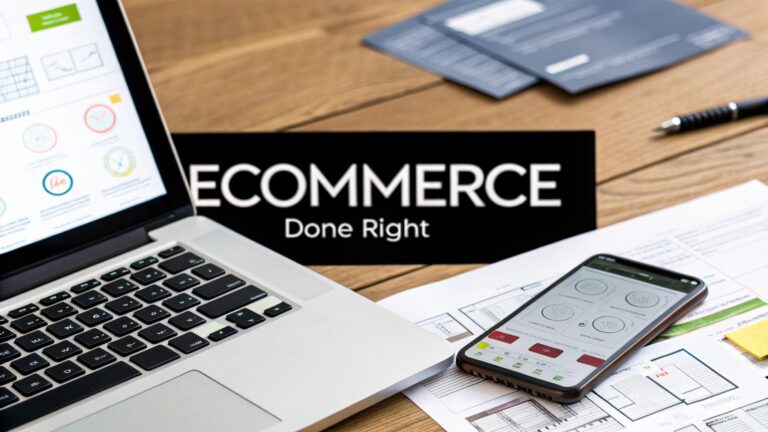Getting your website to the top of Google isn't about some secret formula or trying to outsmart the algorithm. At its core, it's about giving people what they're looking for with genuinely helpful content, all served up on a website that's technically solid and easy for search engines to understand. It's a blend of on-page optimisation, building off-page authority, and maintaining a strong technical foundation. Get these three things working together, and you’re on the right track.
Aligning Your Strategy with Google's Core Mission

Before we get into the nitty-gritty tactics, let's take a step back and think about Google’s own goal. Their mission is simple: to organise the world’s information and make it universally accessible and useful. Every algorithm update, every new feature, it all points back to this one objective.
This means that chasing the latest algorithm tweak is a fool's errand. The only long-term, sustainable way to improve your rankings is to align your strategy with that mission. Focus on creating an excellent experience for your visitors, not just ticking off items on an SEO checklist.
This user-first approach is more critical than ever. In the UK, Google's dominance is absolute, holding around 93.37% of the search market as of early 2025. For most British businesses, it’s the only search engine that matters. Modern Google systems, powered by advanced AI like BERT, are incredibly good at understanding the nuances of language and user intent.
The Three Pillars of SEO
To really get this right, you need to structure your efforts around the three fundamental pillars of SEO. I like to think of them as the legs of a stool—if one is shorter than the others, the whole thing wobbles. A successful strategy requires a balanced approach across all three.
Here's a quick look at how these pillars work together to help you rank higher.
The Three Pillars of SEO at a Glance
| SEO Pillar | Primary Focus | Key Actions |
|---|---|---|
| On-Page SEO | Your website's content and structure. | Keyword research, title tags, meta descriptions, quality content, internal linking. |
| Off-Page SEO | Your website's authority and reputation. | Building high-quality backlinks, brand mentions, social media presence. |
| Technical SEO | How well search engines can crawl and index your site. | Site speed, mobile-friendliness, sitemaps, secure connection (HTTPS). |
As you can see, each pillar plays a distinct but interconnected role in signalling quality and relevance to Google.
A common mistake I see is people getting hyper-focused on one area. You might have a perfectly optimised page from an on-page perspective, but it won’t get far without the authority that off-page SEO provides. Likewise, all the authority in the world won't help if Google can't even crawl your site properly due to technical issues.
It's Not Just About Web Pages Anymore
Remember Google's mission to provide useful information? That doesn't just mean blog posts and articles. The search results are now a rich mix of formats, and video is a huge part of that.
If you’re serious about a comprehensive content strategy, you need to think beyond your website. Learning how to rank YouTube videos on Google can open up a massive new channel for visibility, reaching audiences who prefer watching over reading.
Now, let's dive into the actionable steps you can take to master all three pillars and start climbing those rankings.
Mastering On-Page SEO for Maximum Impact

While the technical health of your site and the links you build are crucial, your on-page SEO is where you have the most direct control. This is all about crafting individual pages so well that they perfectly answer a searcher's query, making it dead simple for Google to understand and rank your content. It goes far beyond just scattering keywords around; it's about creating a genuinely satisfying experience for the user from the second they land on your page.
Think of it this way: your title tag and meta description are your shop window in the search results. Your job is to make them compelling enough to draw someone in, away from all the other competitors on the digital high street. A well-written meta description that nails the page's value can seriously boost your click-through rate (CTR), which is a powerful vote of confidence in Google's eyes.
Perfecting Your Page Titles and Descriptions
Your page's title tag is, without a doubt, one of the most important on-page SEO elements you can influence. For the best results, you'll want to get your primary keyword as close to the beginning of the title as possible. We often call this "front-loading," and it works because it immediately signals the page's core topic to both search engines and people.
For instance, a title like "Our Guide to Growing Beautiful Roses in Your Garden" is okay, but it could be much punchier. A better, more optimised version would be "Growing Roses: A Complete UK Gardener's Guide." It's direct, puts the main term up front, and adds a relevant modifier ("UK Gardener") that really speaks to a specific audience.
Key Takeaway: A compelling title and meta description are your first, and sometimes only, chance to win over a user. With the top search result grabbing an average CTR of 27.6%, making your snippet stand out is absolutely vital for capturing traffic.
Once you’ve earned the click, your content has to deliver on the promise. A classic mistake I see all the time is "thin" content that just scratches the surface and doesn't fully answer the searcher's question. Comprehensive, in-depth content consistently performs better. In fact, the average word count for a first-page Google result is often over 1,400 words. This isn't a license to add waffle; it's about covering a topic so thoroughly that your reader has no reason to hit the back button.
Structuring Content for Readability and Rankings
How you structure your content is just as important as what you write. Nobody enjoys being confronted by a giant wall of text. Using proper headings (H2, H3, etc.) is the best way to break your content into logical, scannable sections. This not only helps users find what they need in a flash but also gives Google clear signposts about the hierarchy and topics covered in your article.
Here are a few practical tips I always follow for structuring content:
- Use Your Primary Keyword in an H2: Pop your main keyword into at least one subheading to reinforce the page's topic.
- Break Up Text with Lists: Use bulleted or numbered lists. They make complex information much easier to digest.
- Write Short Paragraphs: Keep your paragraphs tight—just one to three sentences. This is a game-changer for readability, especially on mobile devices where most users are these days.
Making these structural tweaks is a fundamental step, but many businesses still stumble over simple errors that hold back their rankings. To make sure you're not falling into common traps, have a look at our detailed guide on the common mistakes in SEO and how to avoid them.
Beyond the Basics: LSI Keywords and Internal Links
Ready to take your on-page optimisation a step further? It’s time to think about Latent Semantic Indexing (LSI) keywords. Don't let the fancy name put you off; these are just terms and phrases that are thematically related to your main keyword. For a page targeting "bicycle repair," LSI keywords would be things like "puncture repair kit," "adjusting gears," "brake pads," or "chain lubrication."
Weaving these related terms into your content confirms to Google that your article is comprehensive and has real depth. A simple trick for finding LSI keywords is to check out the "People Also Ask" section in Google's search results or look at the bolded terms in the autocomplete suggestions as you type.
Finally, never underestimate the power of internal linking. This is simply the act of linking from one page on your website to another. It helps Google discover your other content, spreads authority between your pages, and, crucially, keeps users on your site for longer. Whenever you publish a new article, make it a habit to go back and find opportunities to link to it from relevant older posts. It's a simple yet incredibly effective tactic to help you rank higher on Google.
Building Authority with Modern Off-Page SEO

While sorting out your on-page SEO gives you a solid foundation, your website's real authority is built "off-page". It's all about the signals you earn from the wider web. Think of it as your digital reputation. When other authoritative websites link to you, Google sees this as a strong vote of confidence in your expertise and trustworthiness.
This is what modern off-page SEO is all about. Gone are the days of just collecting as many links as you could. Now, the game is about earning high-quality backlinks from relevant, respected sources in your field. Honestly, a single link from a well-regarded UK business journal can be far more powerful than a hundred links from low-quality, irrelevant blogs.
Earning Links That Matter
The best, most sustainable way to get powerful backlinks is to create content that people actually want to link to. We often call these "linkable assets". Instead of just churning out another blog post, you need to think bigger. What unique resource could you create that becomes the go-to reference in your niche?
Here are a few ideas to get you started on creating link-worthy content:
- Original Research and Data: Why not survey local businesses in Norfolk and Suffolk and publish what you find? Journalists and bloggers are always looking for fresh data to back up their own articles.
- In-depth Guides: Aim to create the most comprehensive guide out there on a specific topic. For example, a detailed piece on "Choosing the Right eCommerce Platform for UK Retailers" is an incredibly valuable resource that others will naturally want to reference.
- Free Digital Tools: Think about developing a simple, genuinely useful tool or calculator. A mortgage affordability calculator on a financial advisor's site, for example, is a natural magnet for links.
The trick is to produce something of undeniable value. When you create content that makes other people's articles better just by linking to yours, you've cracked the code to earning backlinks naturally.
It's a common finding in many SEO studies that content over 3,000 words tends to attract significantly more backlinks. This isn't about padding your word count; it's that long-form content is often more comprehensive and, as a result, a much more valuable resource for others to cite.
Beyond Traditional Link Building
Backlinks are still the cornerstone of off-page SEO, but Google’s algorithm has become much more sophisticated. It now considers a much broader range of signals to figure out who the real experts are in any given field.
Brand Mentions
Even if a site mentions your brand name without actually linking to you, it can still work as an authority signal. It shows Google that your business is part of the conversation in your industry. You can encourage these mentions through digital PR—think about issuing press releases or appearing as a guest on local podcasts. It's a powerful strategy.
Online Reviews and Citations
For any business with a local presence, online reviews and citations are absolutely vital. Citations are simply mentions of your business name, address, and phone number (NAP). Positive reviews on platforms like your Google Business Profile and consistent citations across relevant UK directories build a strong local reputation. These signals are crucial for ranking higher in Google, especially for location-based searches. For a deeper look at this, our guide covers several local SEO solutions you need to know about.
How to Spot Good and Bad Links
As you build your backlink profile, knowing the difference between a helpful link and a harmful one is critical. A good link comes from a page that is topically relevant to yours, on a website with its own established authority. A link from the local Chamber of Commerce website to your Norfolk-based business is a perfect example of a great link.
On the other hand, a "toxic" link often comes from a spammy, low-quality site built purely for link schemes, or from websites in completely unrelated industries. You should make it a habit to regularly audit your backlink profile and disavow these harmful links. It's an essential bit of housekeeping that protects your hard-earned rankings.
Fortifying Your Technical SEO Foundation
A technically sound website is the bedrock of any serious SEO strategy. Think of it this way: if Google's crawlers can't efficiently find, understand, and index your pages, even the most brilliant content will struggle to see the light of day. Getting your technical SEO right ensures you aren’t accidentally leaving the handbrake on while trying to climb the search results.
Your website is like a house. The content and design are the beautiful furnishings, but technical SEO is the foundation, the plumbing, and the wiring. If the foundation is cracked or the wiring is faulty, it doesn't matter how nice the furniture is—the house just won't function properly. This is why a regular technical audit isn't just good practice; it's essential.
Prioritise Site Speed and Core Web Vitals
In a world of short attention spans, website speed isn't just a techy metric; it’s a critical part of the user experience. A slow-loading site is one of the quickest ways to lose a potential customer. Google knows this, which is why page speed and a set of metrics called Core Web Vitals are direct ranking factors.
These vitals measure three specific things about what it’s like for a person to use your page:
- Largest Contentful Paint (LCP): How quickly does the main content load? You need to aim for 2.5 seconds or less.
- First Input Delay (FID): How fast does your page respond when someone clicks something? An ideal FID is 100 milliseconds or less.
- Cumulative Layout Shift (CLS): How much does the page layout jump around unexpectedly while it's loading? Try to get a CLS score of 0.1 or less.
You can easily check your site’s performance using Google's free PageSpeed Insights tool. It gives you a clear report and practical suggestions, like compressing your images or cutting down server response times, to improve your scores.
Ensure Flawless Mobile-Friendliness
With most searches now happening on mobile devices, Google has shifted to a "mobile-first" indexing approach. This means it primarily looks at the mobile version of your website to figure out its rankings. A desktop site that looks incredible but is a nightmare to use on a phone will severely hurt your SEO.
Your site must be fully responsive, automatically adjusting its layout to fit any screen, from a big desktop monitor to a small smartphone. Text should be readable without pinching and zooming, and buttons must be easy to tap. Again, Google gives us a free Mobile-Friendly Test tool to quickly spot any problems.
While technical factors like site speed are foundational, they work in tandem with content quality. Statistical evidence shows the top-ranking result on Google gets an average click-through rate of about 22.4%, a figure that drops sharply to around 15% for the second spot. This highlights the immense value of being number one, a position heavily influenced by Google's assessment of content, authority, and user experience. You can discover more insights about Google ranking updates to understand this better.
Master Your Sitemap and Robots.txt
To help Google understand your website's structure, you need two key files: an XML sitemap and a robots.txt file.
An XML sitemap is essentially a map for search engines, listing all the important pages you want them to crawl and index. A well-organised sitemap ensures Google can discover all your valuable content, even pages that aren't heavily linked from elsewhere on your site.
The robots.txt file, on the other hand, gives instructions to crawlers about which parts of your site they shouldn't access. This is incredibly useful for blocking private areas, like a customer login portal, or thin-content pages you don't want showing up in search results. Be careful, though—a mistake in this file could accidentally block Google from your entire site.
Implement Structured Data
Finally, one of the most effective things you can do is implement structured data, often called schema markup. This is a specific type of code you add to your website's HTML that labels different elements on your page, giving Google vital context.
For example, you can explicitly tell Google:
- "This is a product, and its price is £49.99."
- "This is a recipe, and it takes 30 minutes to prepare."
- "This is an article, and its author is Jane Doe."
This information helps Google create "rich results"—those more visual, informative listings you see with star ratings, prices, and event dates. They don't just look better; they significantly improve click-through rates, driving more qualified traffic straight to your site.
Creating Content That Aligns with User Intent
Let's get one thing straight: high-quality content isn't about just stuffing keywords onto a page. It’s about genuinely satisfying the person on the other side of the screen. If you want to rank higher on Google, your content has to perfectly match user intent—the why behind their search. Nailing this is the secret to creating content that doesn't just rank but also builds real trust and authority.
Think of yourself as a helpful expert. If someone asks for a specific tool, you don't lecture them on its history; you show them exactly where to find it. Search intent is no different. Your job is to give the most direct, useful answer to what someone is looking for.
Decoding the Four Types of User Intent
Every single search query can be sorted into one of four main categories. The real trick is matching your content format to the right intent. If you write a massive blog post when a user just wants to find a specific product page, you’ve missed the mark, and your rankings will suffer for it.
Let’s break them down:
-
Informational: The user wants to learn something. Keywords often look like "how to fix a leaky tap," "what is cloud computing," or "why is my laptop slow." Your best bet here is a detailed blog post, an in-depth guide, or a clear video tutorial.
-
Navigational: The user is trying to get to a specific website or page. They'll search for things like "Ibertech Solutions login" or "Facebook." The only way to satisfy this is to be that destination. Simple.
-
Transactional: The user is ready to buy. Keywords will include words like "buy," "deal," or specific product names, such as "buy Microsoft 365 subscription." A clear, well-optimised product or service page is the only thing that works here.
-
Commercial Investigation: The user is planning to buy soon but is still weighing up their options. They might search for "best web design company Norfolk" or "Dell vs HP laptops." This is where comparison articles, detailed reviews, and "top 10" lists shine.
A classic mistake I see all the time is creating content that completely misses the searcher's goal. For instance, writing a 2,000-word article for the keyword "buy running shoes" is a total waste of effort. Someone searching that wants to see shoes, add them to a cart, and check out—not read a novel.
Matching Content Types to User Intent
To make this crystal clear, it’s helpful to visualise how intent, keywords, and content formats connect. Creating the right type of content for the right query is fundamental to seeing your pages climb the search results.
| User Intent | Typical Keywords | Ideal Content Format | Goal |
|---|---|---|---|
| Informational | "how to", "what is", "guide" | Blog Post, Guide, Video | Educate & build trust |
| Navigational | Brand names, "login", "contact" | Homepage, Login Page | Guide users to a destination |
| Transactional | "buy", "price", "discount" | Product/Service Page | Facilitate a purchase |
| Commercial | "best", "review", "vs" | Comparison, Listicle, Review | Help users make a decision |
This table serves as a quick cheat sheet. When you're planning content, always ask yourself which box the user's query fits into, and then build the corresponding asset. It’s a simple check that can save you a lot of wasted time.
Building Content Around Real Questions
Once you’ve figured out the 'why', you need to find the 'what'—the actual questions and problems your audience is dealing with. Good topic research isn't just about chasing high-volume keywords; it's about uncovering the pain points you are uniquely positioned to solve.
A fantastic starting point is Google's own "People Also Ask" section. Just type in a broad topic related to your business and look at the questions that appear. These are real queries from real people, giving you a direct insight into their minds. Answering these questions thoroughly makes your content a one-stop-shop, which Google loves.
The graphic below highlights a few key benchmarks to remember as you get to work.

These numbers aren't strict rules, but they are a good reminder that quality content often requires a serious investment in depth and a commitment to publishing consistently.
Embracing the Helpful Content System
Google's "Helpful Content" update basically made this entire philosophy official. The system is designed to reward content created for people, not just for search engine crawlers. This means your content should leave a visitor feeling satisfied and like they've actually learned something useful.
To make sure you're on the right track, ask yourself these questions about every piece of content you create:
- Does this piece show genuine, first-hand expertise and a real depth of knowledge?
- After reading this, will someone feel they've learned enough to achieve their goal?
- Is this content focused on providing real value, or was it just written to hopefully rank for a keyword?
Producing genuinely helpful content is a long-term game. It demands a steady flow of well-researched, well-written articles and pages. To stay on top of it, using an editorial calendar template can be a lifesaver for planning and organisation.
For businesses that are serious about their online growth, a proper content strategy is non-negotiable. If you need an expert hand in developing a plan that actually drives results, exploring professional search engine optimisation in Norfolk can provide the specialist support you need to get ahead.
Your Google Ranking Questions, Answered
https://www.youtube.com/embed/8NjBWQIaf3I
When you're trying to figure out how to get your website to rank higher on Google, a lot of questions come up. It's a complex world, and I find a few key queries pop up time and time again. Let's get them answered with some straight, practical advice you can actually use for your business.
How Long Does It Really Take to See Ranking Improvements?
This is the big one, isn't it? The honest, no-fluff answer is: it depends. SEO is a long game, not a quick win. It’s more like tending a garden than flicking a switch – you won't see everything in full bloom the next day.
If you’re starting with a brand-new website, you should realistically budget for six to twelve months before you see meaningful, steady traffic coming from search. For an older, more established site that already has a bit of authority, you might notice positive changes within four to six months.
What makes the timeline vary so much?
- Your Competition: Trying to rank for a term like "business IT support" in London is a much tougher and longer fight than ranking for a niche local service in a smaller town.
- Your Website's History: If a site is recovering from a penalty or has a past littered with low-quality content, it’s got a longer road ahead to rebuild Google's trust.
- Your Own Efforts: The amount of work you put in directly affects the speed of your results. Consistent content creation and link building will always speed things up.
My Advice: Settle in for the long haul and be consistent. SEO is a marathon, not a sprint. If anyone promises you a number-one spot in a few weeks, they're selling you snake oil. Real, lasting rankings are built brick by brick over time.
Should I Focus on On-Page or Off-Page SEO First?
That's a bit like asking if a car needs its engine or its wheels. You absolutely need both working together to get anywhere. On-page and off-page SEO are two sides of the same coin, and one is pretty useless without the other.
Think of on-page SEO as your foundation. This is all the work you do on your actual website – from keyword research and content creation to optimising your title tags. It’s how you tell Google what your pages are about and prove they’re relevant for certain searches.
Off-page SEO is what builds your authority. This covers everything you do away from your website, with the main goal being to earn backlinks from other respected sites. These links are like votes of confidence, signalling to Google that your content is valuable and trustworthy. You can have the most beautifully optimised page in the world, but if it has no authority, it will never rank for anything competitive.
A balanced strategy is always the best bet. I always recommend getting your on-page elements sorted first, as you have total control over them. Once that foundation is solid, you can shift more focus to building your site's authority with a steady off-page plan.
Can I Do SEO Myself, or Should I Hire an Agency?
The choice between going DIY or bringing in a professional agency really boils down to three things: your time, your knowledge, and your budget.
Doing it yourself is a fantastic way to learn the ropes and can be very cost-effective, particularly when you're starting out. Many on-page basics, like writing good content and optimising titles, are perfectly manageable for a dedicated business owner. The catch? The learning curve is steep, and proper SEO demands a serious, ongoing time commitment to keep up with algorithm updates and best practices.
Hiring an agency like Ibertech Solutions Limited gives you instant access to a team of specialists who already have the experience, expensive tools, and proven methods. This is often the smartest move for tackling complex technical SEO problems or running a serious link-building campaign. It's a financial investment, for sure, but the return in growth and saved time can be massive.
Sometimes, a hybrid approach works best. You might handle the content creation yourself while letting an agency manage the more technical and authority-building side of things.
Will Using AI for Content Hurt My Google Rankings?
The short answer is no, not if you use it correctly. Google has been quite clear on this: they reward helpful, high-quality content, no matter how it was created. What they care about is E-E-A-T – Experience, Expertise, Authoritativeness, and Trustworthiness.
This means you can absolutely use AI as a powerful assistant in your content workflow. It's fantastic for brainstorming ideas, structuring an article, or just getting past a bout of writer's block.
Where you run into trouble is using AI to churn out heaps of unedited, low-quality articles with zero human input. If the content is generic, inaccurate, or just plain unhelpful, it will fail to rank – it doesn't matter if a human or an AI wrote it. The secret is to use AI to amplify human expertise, not to replace it. Always have a real person review, edit, and add their unique knowledge to anything an AI produces.
It's also worth noting that the digital landscape is influenced by more than just algorithms. Here in the UK, market conditions play a role. Despite Google holding over 90% of the UK search market into mid-2025, regulatory scrutiny is growing. The UK government has been exploring policies that could require Google to offer users different search options and make its ranking results more transparent. You can read more about the UK search engine market share on Statista.com.
Trying to master SEO and implement a strategy that actually drives results can feel like a full-time job. If you're ready to improve your online visibility and grow your business without all the guesswork, Ibertech Solutions Limited is here to help. Our team of experts in Norfolk and Suffolk offers bespoke SEO, web design, and digital marketing services to get your business the rankings it deserves. Contact us today for a free consultation!





